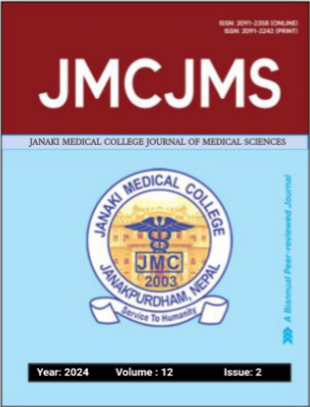Clinical diagnosis of stroke patients using SIRIRAJ stroke score and Computed Tomography
DOI:
https://doi.org/10.3126/jmcjms.v12i02.68960Keywords:
Cerebrovascular Accident, Computed tomography, Clinical Diagnosis, Siriraj Stroke Score, StrokeAbstract
Background & Objectives: Stroke is a significant cause of disability and death globally, with ischemic and hemorrhagic types. Rapid diagnosis is critical, particularly in resource-limited settings where access to neuroimaging is restricted. Thus, this study aimed to diagnose stroke patients using
the Siriraj Stroke Score (SSS) and computed tomography at Janaki Medical College Teaching
Hospital.
Materials and Methods: A total of 97 stroke patients presented within 72 hours of onset at
Janaki Medical College Teaching Hospital, Nepal, were included in this study. Patients were
clinically assessed using the SSS and subsequently underwent CT brain scanning to confirm the
stroke subtype. The SSS was calculated based on consciousness level, headache, vomiting,
atheroma markers, and diastolic blood pressure. The results from SSS were compared with the CT
scan findings to determine the clinical diagnosis.
Results: The study found that 56.7% of the patients had hemorrhagic strokes, with intraparenchymal hematoma being the most common subtype. The SSS showed a strong correlation with CT scan results, particularly for hemorrhagic strokes, where most patients with a score above 1 were accurately diagnosed.
Conclusion: The Siriraj Stroke Score is a valuable tool for initial stroke assessment, especially in
settings where advanced neuroimaging is not immediately available. The study supports using
SSS in early stroke management, which could improve patient outcomes in resource-limited environments.
Downloads
Downloads
Published
How to Cite
Issue
Section
License
© JMCJMS, JMC, Janakpur, Nepal




